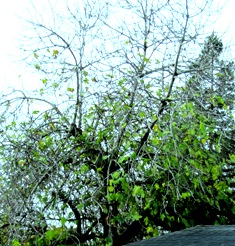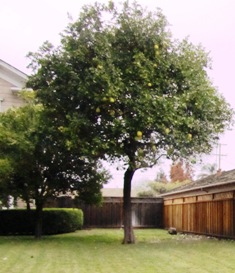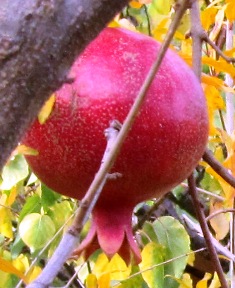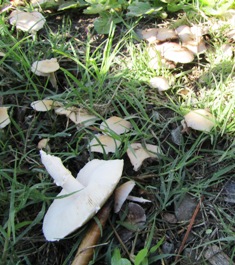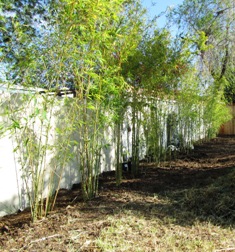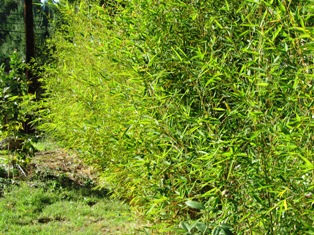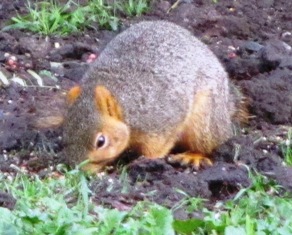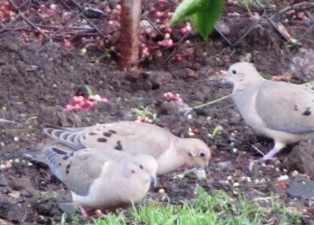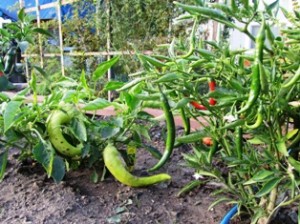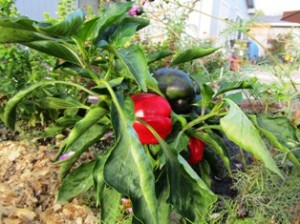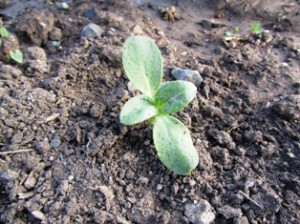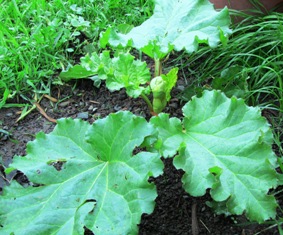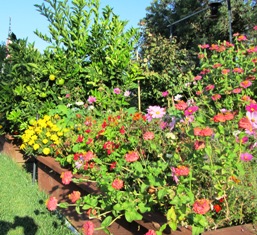Archive for the 'Plants and Trees' Category
Winter, Time of Dormancy for Figs and Other Fruit Trees
Only four days remain until the official onset of winter. Drifting leaves from the Mission fig tree towering above my neighbor’s rooftop catches my attention. The fig’s thick trunk and spreading branches form a scaffold that sways against the western sky, pushed by a storm wind advancing from off the Pacific. It took most of autumn for the grand old fig to shed its canopy. Now most of its leaves lie on the ground like pieces of a discarded garment in Mother Nature’s closet.
Human hands, raccoon paws, and squirrel feet removed the tree’s fruit over the summer and fall. The fig remains picturesque with its lowest branches as thick as its trunk and with some trunks gnarled and covered with green moss.
The grand old fig stands stark and vulnerable, soon to rest in complete dormancy, in contrast to its unabashed fecundity during summer. The tree must await spring’s light and warmth to reawaken. For now, the fig’s heavy, gray bark finds resonance in weathered buildings, barns, and fences built more than a half century ago in this part of Contra Costa County.
During spring and summer, when its sap is rejuvenated and flowing with life-giving nutrients, the fig sprouts a lush canopy of bright green leaves. Later, it prolifically produces sweet fruit that grow as large as a man’s fist.
Mother Nature isn’t as precise as the dates on our calendars.Her seasons ease seamlessly from one into another. Colder and darker days of winter are yet to come. For many plants, the season of cold and storms is a time of rest; a dormant period from which they will emerge anew. The fig will again blossom, leaf-out, produce fruit in a new cycle. This is the promise of spring, the hope of gardeners. Until then, the tree has earned a much-needed rest.
Pruning Sixty-Year-Old Citrus Trees
When a friend who owns a house in San Jose asked for help in pruning her citrus trees (a lime, satsuma mandarin, and a grapefruit) during the first weekend in December, we agreed. The house had a lovely stone courtyard with two large citrus trees that had remained prolific producers in spite of being neglected for the last 20 years. The trees had been planted, she told us, approximately 60 years ago by an aunt.
Standard size citrus trees can reach 20 to 30 feet and spread almost as wide. Dwarf citrus, however, only reaches four to ten feet. The latter can be grown as landscape specimens or in pots where they can be easily moved around to protect them from frost and wind. In really hot, dry conditions, citrus in pots may need daily watering.
Once in San Jose, we checked the trees for diseases and pests. Aside from some of the lime leaves that had turned yellow, suggestive of too either much water or iron chlorosis (simply corrected with a little iron sulfate or chelated iron), the trees otherwise looked pest-free and loaded with ripe fruit.
Wearing gloves and long sleeves to protect against thorns, we shook the trees vigorously to remove unpicked fruit of previous seasons and the current season’s ripe fruit. The shaking yielded a five-gallon bucket and two partially full contractor bags of delectable limes and satsuma mandarins. The owner was delighted to have so much fruit. She even offered us some to make into marmalade, but we explained we had plenty of our own citrus on the farmette.
We carefully pruned out all the old dead branches and began shaping the trees, lifting and cutting branches that pointed down, removing crossed-over limbs, and cutting away branches that compromised the courtyard fence. Our work reduced the height and width of the trees (making it easier to harvest any fruit still hanging).
The work went smoothly. We even had time to tackle the ragged-looking grapefruit tree in the back. By the end of the day, we had freed three beautiful trees from a tangle of dead limbs and picked many pounds of fruit. The trees were once again serving the purpose for which they were planted–heavy producers that enhanced the beauty of the landscape.
Pomegranate: A Jewel of a Fruit with a Long History
This time of year, you’ll find plenty of pomegranates in the markets and on harvest festival tables. It’s an important fruit in Middle Eastern cuisine. In the fall, pomegranate plants produce garnet-colored fruit with a leathery rind.
The fruit ranges in size from that of a large apple to a small kumquat (for ornamental types of pomegranates). The pomegranate’s treasure, however, is hidden inside. There you’ll find bright red juice and glistening seeds that taste sweet or bittersweet and astringent.
The pomegranate was known to the ancient world. Long before the birth of Christianity, the Egyptians viewed the fruit as a symbol of prosperity. The Bible contains numerous references to the pomegranate and its symbolism as an image of fertility.
The fruit is indigenous to Persia (the area that includes the modern countries of Iran and Iraq). The pomegranate’s popularity has spread since ancient times throughout the Middle East, India, Asia, and elsewhere around the world.
Pomegranate has important uses in the ancient Indian Ayurevedic system of medicine, including as a counterbalance of diets high in sugar and fat. In Northern California’s east bay valleys, the plant is easily cultivated. Our neighbors to the left, right, and rear of our farmette all grow pomegranates.
There are many cultivars of the plant (bushes, trees, and ornamental varieties). Our trees are young and still pretty small. The branches are stiff and tend to arch. Small oval leaves create a delicate open pattern–almost a lacy look–in the garden.
The best method of propagation is through cuttings from wood that is at least a year old. The plants are excellent landscape choices. They are not too picky about soil and as they get older are somewhat drought tolerant. Grow in full sun and irrigate young plants. You[ll be rewarded with trees that remain relatively pest-free and bear plentiful fruit.
Ripe fruit still hanging on the tree can split open, revealing the seeds. But many who grow this fruit and appreciate its nutrient, antioxidant, and medicinal value seldom leave these gems on the tree to over-ripen and fall.
Is It a Mushroom, Morel, Truffle, or Toadstool?
I wouldn’t call myself a gastronome when it comes to mushrooms–my taste and enjoyment of them is not that discriminating. I like them in food, but I am not fond of finding them popping up all over the farmette after a rain. My displeasure at seeing them in the lawn, around the raised planter boxes, on the pathways, or in the orchard and garden stems from my not readily knowing which types are beneficial s and which are harmful. There are literally hundreds of different species, some are poisonous.
The mushroom (often called a toadstool) is the visible sign of the presence of a fungus in the soil. The toadstool generally has three parts–a stalk or stem, a cap, and gills. You might think of the hookah-smoking caterpillar perched on top of one in Alice’s Adventures in Wonderland, by English author Lewis Carroll.
Mushroom color varies with the species of fungus that produces the fruiting body. While many have neutral coloring, some, like the poisonous fly agaric (Amanita muscaria) that you would find in the woods associated with conifer and birch trees, has a brilliant red cap with white scales.
Don’t eat mushrooms or toadstools you find growing in the wild unless you are an expert on fungi.
The majority of fungi won’t harm the garden (although some do). If I don’t recognize the type of fungi that is growing, I either ignore them or use a spade to dig them out. I dispose of them in the garbage. Some toadstools are actually beneficial to the soil, adding back in certain nutrients. Such fungi have a symbiotic relationship with garden plants. However, others can have spores harmful to humans.
I’ve used a lot of soil amendment and compost on the property. There may be pieces of rotting wood buried under the dirt. Fungi need a food source to grow. In packed soil and the damp conditions following a rain, toadstools pop up, seemingly everywhere.
Alas, I cannot as yet tell the toadstool from the truffle or morel, so highly desired in the French and English culinary traditions, so I won’t eat any of them. And as for sitting on one, well . . . I leave that for the hairy worm of Lewis Carroll’s imagination.
Bamboo Transforms Stark into Lush in No Time
New to the neighborhood and homesteading, we were offered a patch of clumping bamboo that was growing on the land behind us when we first moved to the Henny Penny Farmette. We worried as many do about the spreading habit of bamboo. The last thing we wanted were neighbors complaining that it had sprouted onto their property.
Back then rotting fences lined the boundaries of our land. The house, too, was in decrepit condition, but Carlos and I saw the potential of the property. We also liked the idea of natural fences or at least plants to soften the stark look of all those boards. Bamboo, we reasoned, made good sense: it was drought tolerant, easy to care for, and quick growing. It could turn a stark, ugly fence into a lush privacy screen in no time.
The vibrant green color turns to a golden amber in the fall and the plant (related to grass) moves gracefully in the wind. The plants were mainly clumping types of bamboo so they were not as likely to spread like thistle in the wind. When we were at the local DIY store, we checked the price of bamboo in pots and quickly realized that the gift we were to receive was worth several thousand dollars.
With shovels in hand, Carlos and a worker began digging along one long fence line on our property. After the planting holes were prepared, he and the worker used the wheel barrow to transfer the bamboo from the back property to ours. The two men planted and deeply watered the bamboo.
Winter rains in 2011 helped the bamboo take hold. It grew well the first year with a little extra watering over the summer. The next rainy season again fostered new growth. Now we have a verdant green fence line of thriving bamboo.
Serve Up Seeds for Furry and Feathered Creatures
Squirrels can contort their bodies into bizarre and exotic positions just to get at the seeds in a bird feeder, as any wildlife watcher can tell you. But they aren’t crazy about all birdseed. Safflower is a good example of a seed loved by birds but not squirrels. The squirrels will forgo a whole feeder of that seed in order to dine on sunflower hearts that is also a favorite of chickadees, finches, and woodpeckers. Pesky squirrels will also paw through a bird feeder to eat other seeds mixed into a commercial wild bird feed but still pass on eating the safflower if it is present.
Since both squirrels and many species of wild birds love sunflower seeds, we grow several types throughout the summer. When fall approaches, we place the dried heads of the sunflowers in an area away from a bird feeder to attract the squirrels and hopefully limit their foraging of food intended for the feathered wildlife. Sometimes it works. However, mourning doves are ground feeders and so are quail. We’ve found the squirrels and the birds foraging together for sunflower seeds.
A squirrel and mourning dove share a meal
The finches enjoy the black Nyger (or thistle) seeds so we keep one feeder of that seed just for them. We love the splashes of yellow (the coloring of their breasts) as they flit around and perch on the feeder to devour their favorite meal. But other birds with small bills like the California quail, pine siskins, towhees, dark-eyed juncos, song sparrows, and purple finches also are attracted by Nyger seeds and will dine often if the feeders are kept filled.
Squirrels and some types of birds particularly enjoy pumpkin seeds and peanuts, so we also put those out when the weather becomes bleak and we’re pretty certain that the wildlife around us isn’t finding much food. During those periods, we also hang suet for the birds, especially those that hang around for the winter but don’t have a lot of food choices such as crows, robins, and the American goldfinches.
When you ensure adequate food supply for the furry and feathered creatures in your backyard, you will be rewarded with many entertaining and heart-warming images. Keep your camera handy for capturing squirrel contortions or surprising pictures of who dines with whom.
Lots of Peppers and Sunflowers Hanging Around
My pepper plants are still producing. It’s a week before Thanksgiving and by this time last year I had harvested all the warm season crops like the peppers. But the plants still have many peppers hanging and are still blooming.
I even have a tomato plant that’s got blooms on it. Of course, most old timer gardeners will tell you that tomatoes won’t set fruit if night-time temperatures aren’t 55 degrees Fahrenheit or higher. So I’ll wait for another week or two to figure out whether or not to pull out the tomato and harvest the peppers. I can use the sweet bells in my Thanksgiving dinner prep.
Yesterday, I laid out on a small stone floor a giant sunflower head that had already dried. The birds, and especially the squirrels, love the seeds. The squirrels practically replant them for me all over the property. The giant sunflower heads laden with seed are my gifts to the wildlife each autumn.
There are sunflowers and then there are the giants that stand seven or eight feet tall with heads the size of dinner plates. The stalks are as thick as the diameter of a coffee mug. It usually takes me a few hours of working with a pick axe to dig out all the stalks and compost them.
I save the seeds from the giants so I can let them dry over the winter and plant again the next year. I’m just guessing but I’ll bet from all the seed heads I’ve saved, I’ve got thousands of seeds. Maybe I’ll package up 50 or so to a bag and give them away at Christmas or sell them at the farmer’s market when it starts up again next year. For now, I’ve got my sights set on making some pepper relish for Christmas season gift baskets of food.
Iris Reward with Sensational Spring Blooms
Few flowers do the double duty of iris in a flower garden. They provide a great background for other flowers and also produce exquisite blooms on their tall stems. Both bearded and beardless iris plants provide textural interest for other perennials, annuals, and herbs, whether in a formal or informal flower bed, along a walkway, or tucked into a corner of a garden.
Iris produce their blooms on stalks that emerge from clumps of stiff, erect, spiked, and pointed green leaves. My iris plants were a gift from the neighbor who owns the property behind the Henny Penny Farmette. The bulbs she gave me had originally been planted by her father and mother, both now deceased. We were thrilled to get the bulbs.
When we planted them on our property, we made sure the soil was amended and we sprinkled in some bone meal and watered well. Then the iris were left alone. We did apply mulch prior to the winter rainy season and because here in the inland valley of the east bay, we can get freezing nighttime temperatures. Those iris plants have rewarded us with spectacular blooms in April each year.
We didn’t know if the bulbs would produce a true blue bloom or some other color, so the anticipation was killing us that first year. Then the buds emerged on tall (roughly three foot stalks) and we could see what was coming. I have to say, the blooms bedazzled us.
Plant height separates the bearded iris into roughly five groups: miniature dwarf, standard dwarf, intermediate, miniature tall, border, and standard tall. Our iris plants fall into the standard tall category. The best time to plant the iris rhizomes is from July to September 15. Set the rhizomes just beneath the soil surface as they do not like being planted too deep. In really cold areas, a thick layer of mulch ensures the rhizome survives alternate freezes and thaws. Lift and divide the rhizomes right after blooming. You can cut the leaves back to six inches for ease in handling the plants.
A note about rhizomes: These thick horizontal stems generate roots from the bottom and the plant’s leaves and flowers emerge from the top. Some plants that grow from rhizomes are bearded irises, calla lilies, and cannas.
Hardy Rhubarb Heralds Spring
I will never forget the long and tortuous Missouri winters of my youth when for days on end the gray sky seemed to hang as low as the horizon line. With hope and great anticipation of nature’s renewal, I waited on spring. Inevitably I would notice the green shoots of tulips, grape hyacinths, and paper white narcissus pushing up through the cold earth.
Gradually, the gray lifted revealing blue. The earth warmed. The strawberries swelled and ripened. The spring peepers kept a chorus down by the pond. Then, inevitably, my grandmother would grab a basket and motion for me to join her in the garden. There we twisted and pulled thick red stalks of rhubarb–one of the earliest vegetables of spring–for pie-making. Grandma always served a dessert at every meal, even breakfast when the white icing she had slathered on just-baked cinnamon rolls would cascade down like melting snow.
So it might not come as a surprise to people who know me that when my husband and I talked about what vegetables we would include in our Henny Penny Farmette garden, I told him rhubarb for jam, jelly, and, of course, pies like my grandmother used to make. We waited until our second year here to put in the rhubarb, and we will let the plants grow for at least a year before harvesting. Next spring, we expect to be able to harvest stalks that are at least an inch thick, possibly for one to two months.
If you’ve never grown rhubarb, you need to know that rhubarb leaves are poisonous. Only the celerylike stalks, with their tart (but also sweet) flavor are used for cooking. You also won’t grow rhubarb from seed but rather from root divisions obtainable at your local nursery. Plant the root divisions (also called crowns) in holes that are about three feet deep and three feet wide and include compost and aged manure with soil. Use mulch to keep the roots moist and to protect them during a hard freeze.
I love the elephant ear-sized leaves and the red stalks (although the stalks can also be green). Best of all, the plant is easy to grow and almost pest free. My favorite variety of rhubarb is the Cherry Red because it is a prodigious producer and has an intensely sweet flavor.
Boxes To Grow Just about Anything
When we arrived at the Henny Penny Farmette our first summer here, the weeds on the property towered over our heads. We knew it would take a lot of work to change the wild, chaotic landscape into something beautiful. After we pulled more weeds than we ever want to remember, we planted a garden, started a bed of herbs, and (during the following bare root season in late January) put in an orchard. That rainy season we had 21 straight days of rain.
My husband Carlos had left to visit his family in the Dominican Republic. The rains didn’t let up. I feared the septic would overflow, take down the young trees, and destroy our herb beds. Near the end of that rainy period, the water level rose high enough to threaten the door into the house. Then the rain stopped.
When Carlos returned, he hired some workers to help us reconfigure the landscape, move dirt, and create a level backyard. We put in a small lawn and gravel paths that defined the entire space at the back of our property. We also raised one area of the yard where the septic could drain in a different direction than the house if it rained like that again.
Carlos incorporated into the overall landscape design several planting boxes in which to grow our berries as well as flowers. The soil here is heavy clay that turns to concrete in the summer. Planting boxes allows us to control the soil, enriching it with nutrients and compost as needed. The gravel paths enable us to move around the acreage during the rainy season, inspecting the boxes of plants, without getting getting mired in mud. The cost to build each box is about $125.00.
Planting boxes allow us to meet each each plant’s needs, for example, acid-soil for blueberries, or great drainage for roses. I first observed raised beds in massive planting boxes during a trip to Russia in the late 1990s. In a centuries-old village along the Volga, I saw vegetables and herbs flourishing under an apple tree planted in the center of a massive box. Our Henny Penny Farmette planting boxes are 4 ft. by 6 ft., so we wouldn’t grow trees in the boxes. However, we have planted a citrus or fruit tree between the boxes. These raised beds in frames truly make it possible to grow almost anything and create a sense of order out of the wild chaos of nature.
 Facebook
Facebook Goodreads
Goodreads LinkedIn
LinkedIn Meera Lester
Meera Lester Twitter
Twitter




